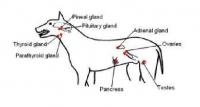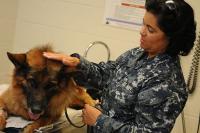Addison's Disease
Addison’s disease, also called hypoadrenocorticism, is when your pet’s adrenal glands produce too little of certain hormones like cortisol and aldosterone. These hormones affect the salt, potassium, and water balance in your pet’s blood stream, maintain normal blood sugar levels, play a vital role in your pet’s immune system, and help the body cope with stress. All of these hormones need to be tightly regulated in order for your pet to function properly, and without them, your pet can quickly get into a life-threatening situation.
What Causes Addison's Disease
Addison’s disease has multiple forms, for which the causes are all different. Typical Addision’s disease is also called the primary adrenal form, while the secondary form is the pituitary form. There is also an atypical form of the disease for which the causes are more external.
The majority of dogs affected by Addison’s disease have an immune reaction occuring within their bodies where the body mistakes the cells that create cortisol and aldosterone as a threat and destroys them. When this occurs, the necessary functions of these hormones cannot be carried out.
In far fewer cases, dogs may develop the secondary or pituitary form of Addison’s disease. In this form, a hormone produced by the pituitary gland called ACTH is not flowing adequately. This hormone is needed to tell your dog’s adrenal glands to produce cortisol and aldosterone, and without adequate flow, the glands will not do so.
Symptoms of Addison's Disease
Unfortunately, because Addison’s disease is a chronic condition where the symptoms build up over time, the early signs are easy to write off as being caused by something else. Also, the signs are often very mild and come and go, so a veterinarian will often treat your pet for the symptom itself, instead of searching for an underlying cause.
Earliest signs of Addison’s disease include lethargy, weakness, vomiting, diarrhea, and a decreased appetite, all signs that can be attributed to other conditions, especially since the symptoms will come and go. Early on, it’s easy to misread these symptoms as mild, fleeting signs that pass with diet change, antinausea medications, or even just time.
Over time, you’re likely to notice, though, that these sudden bouts of illness often come after a period of stress, like moving, guests in your home, your dog being boarded in a kennel, a big party, or any other rare occurrences that could put emotional stress on your dog.
Diagnosis of Addison's Disease
Diagnosing Addison’s disease is not a simple process, because red flags for the disease will fluctuate over time. When a dog presents to a hospital in a crisis, routine bloodwork will likely show an elevated potassium level and low blood sodium. She may also have an elevated BUN and creatinine level or have a low specific gravity to her urine. However, these alone are not enough to diagnose Addison’s disease, and could potentially be normal if your dog is not in a current state of crisis when the samples are collected.
The only way to reach a conclusive diagnosis of Addison’s disease is with a blood test called an ACTH stimulation test. The level of cortisol in your dog’s blood will be measured, and then he will receive an injection of cosytropin, a medication that is similar to the ACTH hormone produced by your dog’s pituitary gland. Later, another blood sample is taken, and the cortisol levels are measured again.
Treatment and Prognosis
Treatment for Addison’s disease is usually medication for the rest of your dog’s life. These medications will vary based on the form of the disease your dog has. Both forms of the disease will usually require oral medications, but the primary disease will often also require treatment with monthly injections. In either case, your dog can still live a long, healthy life, provided he is closely monitored and medications are adjusted as needed.
All articles are reviewed and maintained by whiskerDocs team of veterinary experts.



